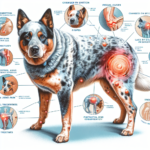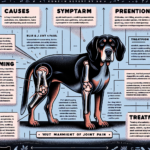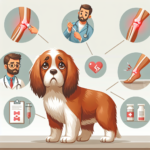American English Coonhound Joint Pain: Causes, Symptoms, Prevention, and Treatment

Introduction
The American English Coonhound, a breed known for its exceptional hunting skills and friendly demeanor, has a rich history that dates back to the early American settlers. Originally bred from English Foxhounds, these dogs were developed to hunt raccoons and other small game in the rugged American terrain. Characterized by their muscular build, keen sense of smell, and high energy levels, American English Coonhounds are both excellent working dogs and loyal family pets.
Like many breeds, American English Coonhounds are prone to certain health issues, with joint pain being a significant concern. Joint health is crucial for this breed due to their active lifestyle and the physical demands placed on their bodies. Understanding the causes, symptoms, prevention, and treatment of joint pain in American English Coonhounds is essential for ensuring their long-term health and well-being.
Breed-Specific Joint Pain Risks
Genetic Predisposition
American English Coonhounds, like many other breeds, have a genetic predisposition to joint-related issues. Common conditions include hip dysplasia, elbow dysplasia, and arthritis. Hip dysplasia occurs when the hip joint does not fit together perfectly, leading to wear and tear over time. Elbow dysplasia involves abnormal development of the elbow joint, causing pain and lameness. Arthritis, a degenerative joint disease, can develop as a result of these conditions or independently as the dog ages.
Age-Related Risks
As American English Coonhounds age, the risk of developing joint pain increases. Typically, signs of joint issues may start to appear in middle age, around 5 to 7 years old. However, some dogs may show symptoms earlier, especially if they have a genetic predisposition or have experienced significant joint stress due to their activity levels.
Activity Level and Joint Stress
American English Coonhounds are known for their high energy levels and need for regular exercise. While their active lifestyle is beneficial for their overall health, it can also contribute to joint stress. Activities such as running, jumping, and hunting can put significant strain on their joints, potentially leading to wear and tear over time. It is essential to balance their exercise needs with measures to protect their joint health.
Common Symptoms of Joint Pain in American English Coonhounds
General Symptoms
Owners should be vigilant for common symptoms of joint pain in their American English Coonhounds. These symptoms include:
- Limping or favoring one leg
- Stiffness, especially after rest or exercise
- Reluctance to move, jump, or climb stairs
- Decreased activity or interest in play
- Swelling or heat around the joints
- Whining or showing signs of discomfort when touched
Breed-Specific Symptoms
In American English Coonhounds, joint pain may manifest in specific ways due to their unique physical characteristics and activity levels. For instance, they may show a noticeable decrease in their hunting or tracking abilities, or they may become less enthusiastic about outdoor activities they once enjoyed.
When to Consult a Vet
If you notice any of the above symptoms in your American English Coonhound, it is crucial to consult a veterinarian promptly. Early diagnosis and intervention can significantly improve the prognosis and quality of life for dogs with joint pain. Regular veterinary check-ups are also essential for monitoring joint health and catching any issues early.
Preventive Measures for Joint Health
Exercise Recommendations
Maintaining an appropriate exercise routine is vital for the joint health of American English Coonhounds. Low-impact activities such as walking, swimming, and controlled play are excellent options. These exercises help keep the joints mobile without causing excessive stress. Avoid high-impact activities like jumping or running on hard surfaces, which can exacerbate joint issues.
Dietary Suggestions
A balanced diet rich in essential nutrients can support joint health. Consider incorporating foods or supplements that contain glucosamine, chondroitin, and omega-3 fatty acids, which are known to promote joint health and reduce inflammation. Consult your veterinarian for specific dietary recommendations tailored to your dog’s needs.
Weight Management
Maintaining a healthy weight is crucial for reducing joint stress in American English Coonhounds. Excess weight can put additional pressure on the joints, exacerbating pain and discomfort. Regular exercise and a balanced diet are key components of weight management. Monitor your dog’s weight and body condition regularly, and consult your veterinarian for guidance on achieving and maintaining a healthy weight.
Early Screening and Monitoring
Early screening and monitoring can help detect joint issues before they become severe. Regular veterinary check-ups should include assessments of joint health, especially as your dog ages. Your veterinarian may recommend specific screening tests, such as X-rays or joint fluid analysis, to identify any early signs of joint problems.
Treatment Options for Joint Pain
Non-Surgical Treatments
Non-surgical treatments are often the first line of defense against joint pain in American English Coonhounds. These may include:
- Medications: Nonsteroidal anti-inflammatory drugs (NSAIDs) can help reduce pain and inflammation. Your veterinarian may also prescribe pain relievers or joint supplements.
- Physical Therapy: Physical therapy can improve joint mobility and strengthen the muscles around the joints. Techniques such as hydrotherapy, massage, and controlled exercises are commonly used.
- Lifestyle Adjustments: Modifying your dog’s activity levels and providing a comfortable living environment can help manage joint pain. Ensure your dog has a soft, supportive bed and avoid activities that may exacerbate joint stress.
Surgical Options
In severe cases of joint pain, surgical intervention may be necessary. Common surgical options for American English Coonhounds include:
- Hip Replacement: Total hip replacement can provide significant relief for dogs with severe hip dysplasia.
- Arthroscopy: This minimally invasive procedure can be used to diagnose and treat joint issues, such as removing loose cartilage or repairing damaged ligaments.
- Joint Fusion: In cases of severe arthritis, joint fusion (arthrodesis) can stabilize the joint and reduce pain.
Alternative Therapies
Alternative therapies can complement traditional treatments and provide additional relief for joint pain. These may include:
- Acupuncture: Acupuncture can help reduce pain and inflammation by stimulating specific points on the body.
- Hydrotherapy: Water-based exercises can improve joint mobility and reduce pain without putting stress on the joints.
- Massage: Regular massage can help relax muscles, improve circulation, and reduce joint pain.
Lifestyle and Management Tips
Daily Care Routine
A consistent daily care routine can help manage and alleviate joint pain in American English Coonhounds. This routine may include:
- Regular, low-impact exercise to maintain joint mobility
- A balanced diet with joint-supporting nutrients
- Weight management to reduce joint stress
- Providing a comfortable, supportive bed
- Administering any prescribed medications or supplements
Modifying the Home Environment
Making your home more comfortable for a dog with joint pain can significantly improve their quality of life. Consider the following modifications:
- Install ramps or steps to help your dog access furniture or climb stairs
- Provide orthopedic beds that offer extra support for sore joints
- Ensure food and water bowls are at a comfortable height to reduce strain
- Use non-slip mats or rugs to prevent slipping on hard floors
Long-Term Management
Long-term management strategies are essential for keeping your American English Coonhound active and happy despite joint pain. These strategies may include:
- Regular veterinary check-ups to monitor joint health
- Adjusting exercise routines as needed to accommodate your dog’s condition
- Continuing with any prescribed medications or supplements
- Exploring alternative therapies to provide additional relief
FAQs About American English Coonhounds and Joint Pain
What are the early signs of joint pain in American English Coonhounds?
Early signs of joint pain include limping, stiffness, reluctance to move, and decreased activity levels. If you notice any of these symptoms, consult your veterinarian promptly.
Can joint pain in American English Coonhounds be prevented?
While it may not be possible to prevent joint pain entirely, you can take steps to reduce the risk. These include maintaining a healthy weight, providing a balanced diet with joint-supporting nutrients, and ensuring regular, low-impact exercise.
Are there specific exercises that are better for American English Coonhounds with joint pain?
Yes, low-impact exercises such as walking, swimming, and controlled play are ideal for dogs with joint pain. These activities help maintain joint mobility without causing excessive stress.
What dietary supplements can help with joint health in American English Coonhounds?
Supplements containing glucosamine, chondroitin, and omega-3 fatty acids can support joint health and reduce inflammation. Consult your veterinarian for specific recommendations.
When should I consider surgery for my dog’s joint pain?
Surgery may be considered if non-surgical treatments are not providing sufficient relief and your dog’s quality of life is significantly affected. Your veterinarian can help determine the best course of action based on your dog’s condition.
Conclusion
Joint pain is a common concern for American English Coonhounds, but with proper care and attention, it can be managed effectively. By understanding the causes, symptoms, prevention, and treatment options, you can help ensure your dog maintains a high quality of life. Regular veterinary check-ups, a balanced diet, appropriate exercise, and a comfortable living environment are all essential components of joint health. By taking proactive measures and consulting your veterinarian regularly, you can help your American English Coonhound live a happy, active life despite joint pain.




